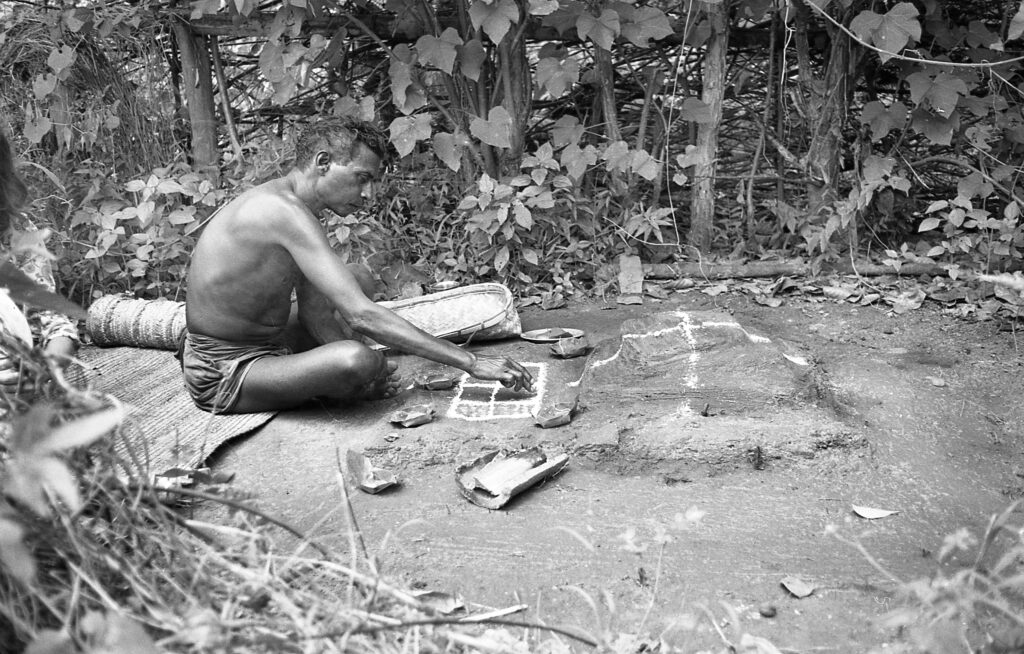Introduction to the Ho photo section 05 Religion/02 Shamanism Bonga worship.
----
SHAMANISM, BONGA WORSHIP.
Generically the word ‘bonga’ refers to spirits. About a third of Ho men happily admit that they have a ‘guru bonga’ or teacher spirit. About a quarter of Ho women will talk about their ‘guru bonga’. These guardian spirits are a bit like what western educated people might call their inner conscience, that feeling that we all have about what is good or bad, morally right or wrong in life. For the Ho a ‘guru bonga’ is in some sense a person’s alter ego. Most Ho will in some way respect and look after their ‘guru bonga’.
A person, who worships their ‘guru bonga’ with intensity and has a small altar to it near their house, is called a ‘soka’ or ‘dewa’ a seer or witch doctor. Such people are often consulted to solve people’s psychological problems or questions. Their ‘guru bonga’ will have introduced them to one of the multitude of tame domesticated village spirits, ‘hatu bonga-ko’, or wild undomesticated forest spirits, ‘bir bonga-ko’. People know which spirits other people worship and are in touch with. They consult the ‘soka’ that who can go into trance and contact the sprit that they think is affecting them. A ‘soka’ will often go into trance to get advice about their own problems.

In the photograph above Bamiya Champia Manki j setting up an altar to the bongas that he worships. In front of the raised steps of the altar he is drawing a set of squares with rice flour. The number of white dots each refer to one of the many bongas that he worships. He will then sacrifice a chicken to them. Then he will pick up the winnowing fan that is beside him and is full of round seeds, usually of lentils. He will place the palm of his right hand over the seeds and chanting the names of his bongas he will gyrate his hand over the seeds until it produces a tingling sensation in his sensitive palm. This tingling will go up his arm and into his entire body putting him into trance when he will be in contact and at one with is bonga. He can then be asked a question or will ask a question himself and will answer with the voce of the bonga.
When a people wake up in the morning, they will often talk about what they dreamt that night. They will say what they ‘did’ during the night and which spirits they met and what happened, almost as if they were in some sense awake and active. Such discussions can often be very intense as well as amusing.
There are many, many different ‘bonga-ko’, bongas. ‘Bageya bonga’ is very commonly referred to. He is a mischievous ‘bir bonga’, who hangs around the village paths and causes a person to trip up or step on a thorn. He also makes frightening noises in the forest. Annually they hold a ceremony when the children of the village go round beating ‘Bageya bonga-ko’ out of the thatch rooves of their houses and bushes overhanging the paths. They drive them out beyond the village boundary, out of the tame domesticated world and into the wild and untamed world where they belong.
The world of the ‘bonga’ dominates the life of the Ho tribals. ‘Singbonga’ is the greatest of all the bongas. In effect he is the ultimate creator God, to whom only a white cock is sacrificed. He controls all the multitude of other bongas. The Catholic Jesuit missionaries, who have created a syncretic form of Christianity that most Ho people near Chaibasa now follow, refer to the Christian deity as ‘Singbonga’.